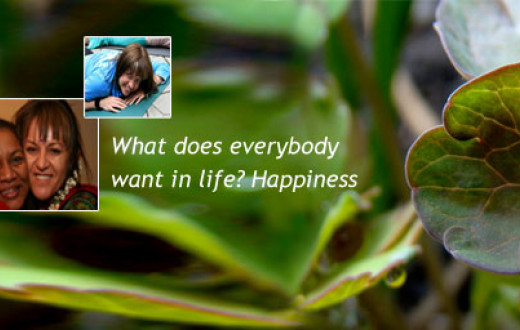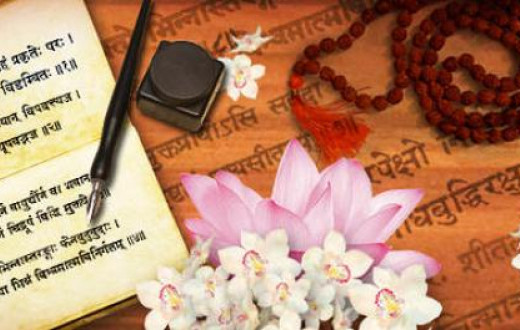Bangalore, India

When skilfulness blossoms within us, then that is Yoga. It is said “Yoga karmasu-kaushalam”. When we do something, we do not do it half-heartedly thinking ‘Will this happen or not?’, or, ‘May be it will be only half-done or so’, or, ‘Oh! This is going to take a lot of time’, etc. Once you decide upon something, just do it. When things start to happen merely by our thinking about them, then that ability is called a Siddhi (extraordinary ability). The goal of human life is to be able to gain this Siddhi, and not just to enjoy the pleasures and material gains of the world.
A crown is usually very heavy,
and it symbolizes responsibilities.
One who wears the crown is
responsible for the entire society.
So it can be a great burden for the
one who wears it. But if you were
to carry out all your responsibilities
and duties as lightly and effortlessly
like a peacock’s feather, then you
would not feel any burden at all.
That is what the peacock feather
on Lord Krishna’s crown means.
India would be not be India if you take away Lord Krishna, and the epics of Ramayana and Mahabharata. These epics are like the two eyes of our country, and are collectively called as Itihasa. They are not related to just one religion or school of thought. They are deeply connected with our entire culture and heritage. Ramayana and Mahabharata are read and discussed in every village of our country. The speciality of these epics is that it is not like they took place once upon a time and are not happening anymore. No, these epics are alive and are happening even now. There is a Mahabharata happening every day, in everyone’s life. There is a discourse from the Gita that is coming true every day.
Janmashtami is the day when we celebrate the birth of Lord Krishna. Lord Krishna signifies Ananda (bliss, pure happiness). We express any happiness by celebration. So Janmashtami is celebrating the birth of Bliss. It is the day when that (divine) joy became manifest. Actually, it is not right to use the word ‘birth’ here. Lord Krishna was never born. That (divine) joy was always present, but it is on this day that it became manifest and evident (in the form of Lord Krishna). So where should you look for Lord Krishna? Everywhere! Lord Krishna says – ‘One who sees Me everywhere, in everyone, and sees everyone in Me is truly intelligent’. Now, no one wants to be foolish in this world. Everyone wants to be intelligent. So, one who recognizes the Parmatma (Supreme soul or all-pervading one Consciousness) as that Anand-tattva (the element of Bliss) that is manifest throughout Creation is truly intelligent. Everything has emerged from that Anand-tattva. This is the special message of Janmashtami. What does one need for this? You need to be innocent at heart; you should have that child-like innocence. It is said – ‘Bhole bhaav miley Raghurai’ (One attains the Lord through the innocence and purity of feelings).
Today’s knowledge is this: It’s time to seriously enjoy and celebrate! (Laughter) You can realize Lord Krishna only through deep rest. You cannot realize Lord Krishna through your struggle and efforts. And when can you get that deep rest? Deep rest happens when your mind is not restless and entangled with feverish desires; when it is not caught up in cravings and aversions. It is in those moments of deep rest that one witnesses the birth of Lord Krishna (here meaning divine bliss).
You should look at Lord Krishna’s birth from a more spiritual point of view. Devaki (Lord Krishna’s mother) represents the physical body, while Vasudeva (Lord Krishna’s father) represents the Prana (the vital life-force). So when the Prana flows through the body, then Ananda (bliss, represented by Lord Krishna) is born. But at that time, the ego (represented by Kamsa, Lord Krishna’s maternal uncle and an evil King) wants to destroy the bliss. Where there is joy, there cannot be ego. A person who is full of joy will never behave wrongly with anyone. Such a person will not go about hurting people and create problems for others. One who troubles others is actually suffering himself, and is hurt or wounded in some way. Such people give misery and suffering to others around them. One who has suffered injustice tries to do injustice with others and make them suffer. A person who is happy and content will never trouble anyone else in anyway. Such a person will never steal from others. So knowledge, happiness and love are the greatest enemies of the ego. Lord Krishna is the symbol of love and joy. How can the ego survive where there is love? The ego is only scared of love, nothing else. That is because ego has to bow down before love. No matter how great a person may be in the world, he has to melt before the love of his own child. When the child falls sick, then no matter how strong and brave the person may be, he melts out of love and concern for the health of his own child. He naturally gets worried. So love, happiness and naturalness are the greatest enemies of the ego. And what does Lord Krishna represent? He is the symbol of happiness, joy and being natural. He is the very source of bliss.
One of Lord Krishna’s many
names is Maakhan-chor
(one who steals butter). When
butter is formed, it floats on
the surface and does not sink
to the bottom of the vessel. So
it is both light and extremely
nutritious also. So when our
intellect becomes refined and
mature in this same way, then
we become Sthithaprajna,
i.e. one who is equanimous at
all times. But one who can steal
the hearts and minds of even the
most equanimous ones is Lord
Krishna!
This is why there is a war between ego and love, because ego melts and disappears when love dawns within. Kamsa represents the ego, and ego is born along with the birth of the body. Devaki (the body) is Kamsa’s sister. When Lord Krishna was born in the prison cell, all the prison guards fell asleep. When there is no happiness and joy (Lord Krishna), the body feels like a prison. So when love (Lord Krishna) was born in this prison (body), all the senses (symbolized by the prison guards) fell asleep. The five senses – the eyes, ears, nose, tongue and skin – are the guards of the body, and they always look outwards for joy. They are actually the guards of Kamsa (ego). So they fall asleep when one turns inwards towards the source of joy, the bliss that is born within (Lord Krishna). Now after being born, Lord Krishna had to be taken to another place for the sake of protection and safety (from Kamsa). So Lord Krishna went to Vrindavana after being born, to the house of Nanda and Devi Yashoda. So when you look deeper into these stories, you will be able to understand their greater spiritual meanings and values. The morals and importance of these stories and events are not limited to one particular place or time; whether you consider the Ramayana or the Mahabharata.
Do you know why Lord Krishna stuck a peacock feather on his crown? How many of you do not know the secret behind this? You know, Lord Krishna never walks or stands in a straight manner. His one leg rests completely on the ground and another is off the ground resting only on its toe. So he stands askew but talks very directly. Why the peacock feather on the crown? A crown is usually very heavy, and it symbolizes responsibilities. One who wears the crown is responsible for the entire society. So it can be a great burden for the one who wears it. Whom do you hold responsible when something goes wrong in the society? You hold the king accountable for the society, isn’t it? So the crown on a king’s head represents the burden of responsibility that he carries. But if you were to carry out all your responsibilities and duties as lightly and effortlessly like a peacock’s feather, then you would not feel any burden at all. That is what the peacock feather on Lord Krishna’s crown means. It symbolizes having being able to shoulder many responsibilities without feeling burdened by them.
God never feels His own creation to be a burden for Him. A mother never feels that her children are a burden for her. In the same way, Lord Krishna, who is also called Yogeshwara (Supreme among Yogis) never feels that any responsibility is a burden. Every responsibility feels light and easy. That is why his crown is adorned with a peacock feather. Just like a peacock’s feather has so many colours, so also He has many responsibilities but they are not a burden for Him at all. They simply appear to be a game.
One of Lord Krishna’s many names is Maakhan-chor (one who steals butter). From milk we get curd, and from curd we get butter. Milk is liquid and very nutritious, from that we get curd which is thicker and more refined. And by churning the curd we get butter. When butter is formed, it floats on the surface and does not sink to the bottom of the vessel. So it is both light and extremely nutritious also. So when our intellect becomes refined and mature in this same way, just like butter and when we blossom in knowledge, then we become Sthithaprajna, i.e. one who is equanimous at all times. But one who can steal the hearts and minds of even the most equanimous ones is Lord Krishna! Lord Krishna is pure attraction. The only one who has the ability to attract and lure away the most wise and knowledgeable of persons is Lord Krishna. Lord Krishna is one who can attract the most dispassionate and detached wise saints and sages. A wise saint is one who has become ripened in knowledge and wisdom (like butter), but one who can steal the heart and mind of such a wise one is who Lord Krishna is. That is why He is called Maakhan-chor. Lord Krishna alone can melt the heart and stir the mind of the most dispassionate and wise person. And how does He do that? It is by love.
Ok, can you all try to say ‘Ka’ (the first syllable in Lord Krishna’s name) without the accompanying ‘-a-’ sound? Just try. (The audience tries but gives up soon after). See, no matter how hard you tried you were not able to do so. Is it possible to do so? It is simply impossible. So when we try to utter ‘Ka’, that very instant we are transported to the very Source from where this sound originates, and that is the Brahman. It is the space from where voice and sound return back, because the Brahman or the Atma-tattva (the Soul or Self as the fundamental element pervading all creation) cannot be reached through sound or words. In the space of the Brahman, the chattering mind comes to rest, there is no voice or sound, and there is a profound experience of stillness. In that state one slips into deep meditation, and you become one with the Self. So, trying to say ‘Ka’ without the ‘-a-’ sound is a meditation in itself. You should all try this sometime, whether before going to sleep or after getting up in the morning or at any time of the day. Just try doing this and then observe what happens in your mind and intellect. You will find that suddenly everything comes to a standstill and there is a deep silence that is born around you. In that state you go deep in wonder, and a beautiful innocence dawns within you. When you were small, you would try to repeat and say every word that you heard innocently. You need to return to that same state of innocence, which takes you to the Source from which all words and sounds originate.
In the Bhagavad Gita, Lord Krishna says:
Purvabhyasena tenaiva hriyate hy-avaso-api sah |
Jijnasur-api yogasya shabda-brahmativartate || (6.44)
He says – ‘Even the wise one who is inquisitive about Yoga eventually moves beyond words and transcends them to reach their Source (Brahman)’.
Today people from all over the world are connected with us and watching the celebrations live from thousands of Art of Living centres across the world. So we have gathered from all over the globe to celebrate Janmashtami – the festival of Bliss. We have to bring about waves of such happiness in our society today. This is each and everyone’s duty.
Lord Krishna is Sanatan (meaning that which is eternal and never-ending). One who is Anadi (without beginning) and Ananta (without end) is called Sanatan. It means that which has always existed and is ever present. No one knows where it began. Such is the knowledge that Lord Krishna gave.
Lord Krishna tells Arjuna – ‘I and you have taken birth several times, but I remember all those lifetimes and you do not. We are both Anadi – no one knows how many times we have incarnated and taken birth here. We come in this world, we depart from it, and we will come again’.
So we say “Tat tvam asi” (Meaning: You are That), and we also say “Sarvam khalvidam Brahmasi” (Meaning: Everything is Brahman). “Tat tvam asi” means you are That, and That (the Self or consciousness) is within you. Then it is also said “Aham Brahmasmi”; meaning “I am Brahman”. So, sometimes you find that Lord Krishna says ‘Come take refuge under Me’, while sometimes He says ‘Take the refuge of God’. Both are correct in how they are said. The duty of a Guru is to take a person forward from where he is on the Path. Before Lord Krishna revealed His Vishwa-Rupa (supreme universal form) to Arjuna, He said:
Ishvarah sarva-bhutanam hrida-deshe Arjuna tisthati |
Bhramayan sarva-bhutani yantrarudhani mayaya || (18.61)
He says that God resides in everyone’s hearts. And then by revealing His Vishwa-Rupa form to Arjuna, He showed him that everything resides within Him, after which He says, ‘Surrender everything and take refuge in Me alone’.
The Gita has been interpreted in thousands of ways, called Tikas. But the essential thing is that the Truth is one, but it is explained in different ways from time to time (depending upon the need and conditions of mankind at the time). And there is contradiction right from the beginning to the very end in Gita. Arjuna himself asks Lord Krishna, ‘O Lord! Tell me one sure way to be free from misery. I am confused listening to so many ways. One moment you suggest one path, the next moment another path. I am already confused and dejected, why are you confusing me further?’ See, the Bhagavad Gita shows a unique way of helping a person go step by step towards Divinity, towards the Self. There is no other scripture equal to the Gita. There is no other scripture other than the Gita that leads one to the Truth through contradiction after contradiction.





















































